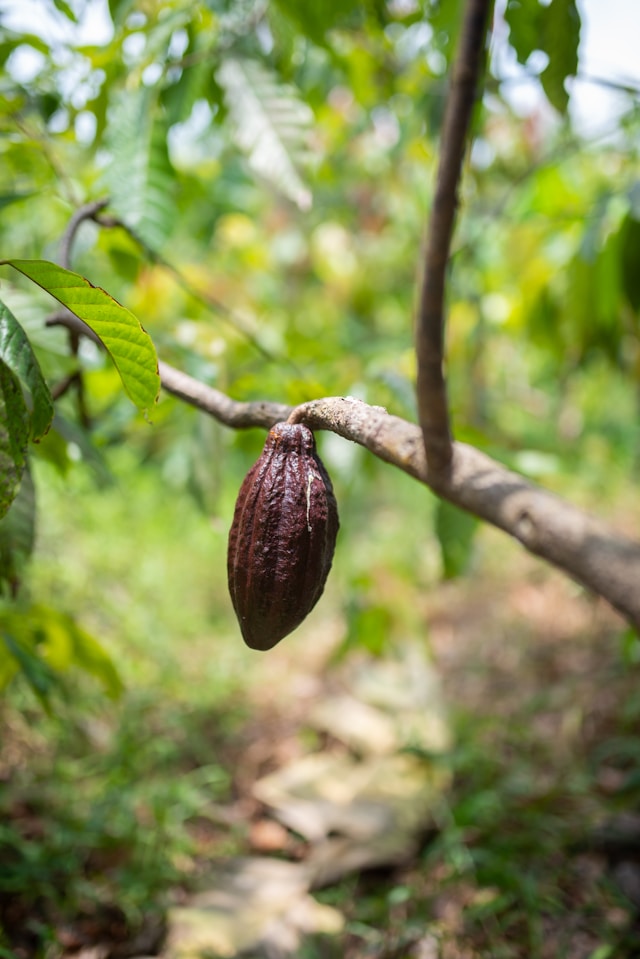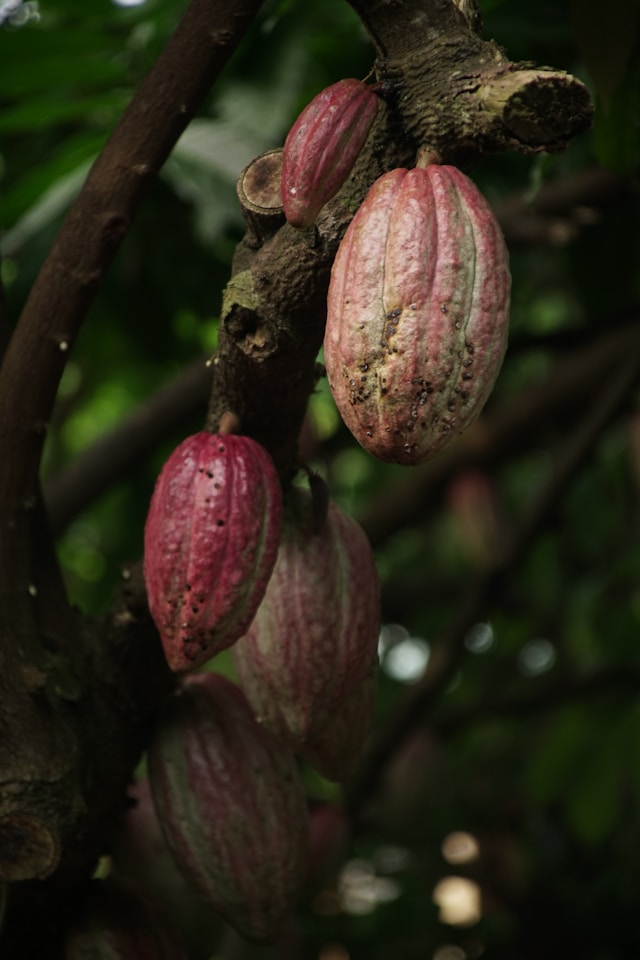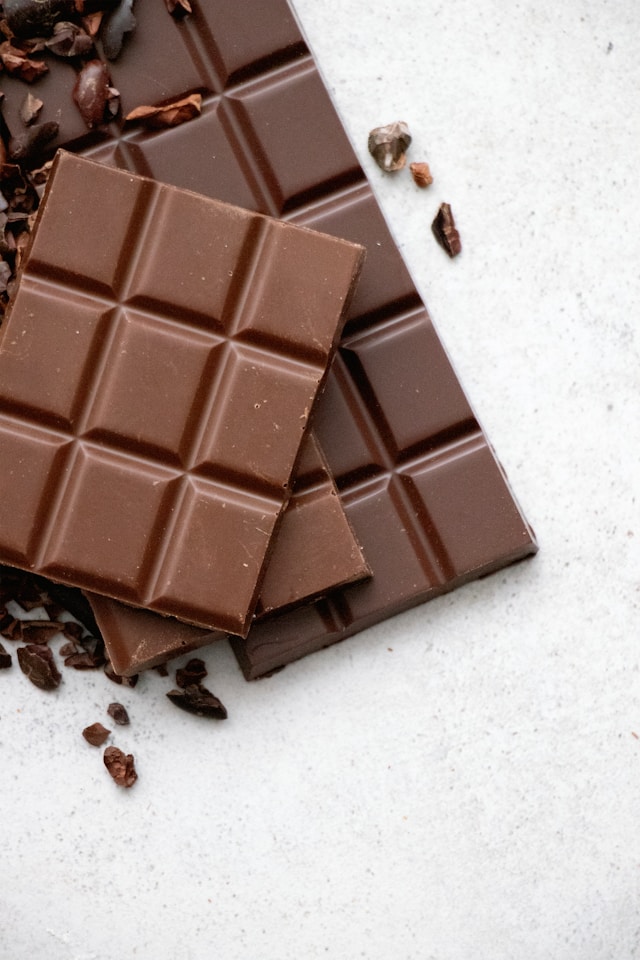COCOA FARM

What is cocoa ?
Cocoa is the key ingredient behind one of the world’s most beloved treats: chocolate. It comes from the seeds of the cacao tree (Theobroma cacao), a tropical plant native to Central and South America. The word Theobroma means “food of the gods,” which reflects the high value ancient civilizations such as the Mayans and Aztecs placed on cocoa, both as a sacred beverage and a form of currency.
The cacao tree produces large, colorful pods that contain 20 to 60 seeds, commonly called cocoa beans. These beans are fermented, dried, roasted, and processed to produce cocoa mass (liquor), cocoa butter, and cocoa powder — the three main components used in chocolate production.
Cocoa’s flavor and quality depend on many factors, including the variety of the tree, soil conditions, climate, fermentation method, and post-harvest handling. There are three main varieties of cacao: Criollo (rare and fine-flavored), Forastero (common and hardy), and Trinitario (a hybrid with good flavor and resilience).
Besides its delightful taste, cocoa is rich in antioxidants and flavonoids, and has been linked to various health benefits when consumed in moderation — such as improved heart health, cognitive function, and mood.
Today, cocoa is grown primarily in the tropical regions of West Africa, Southeast Asia, and Latin America. However, not all cocoa is created equal. The global industry faces significant challenges, including deforestation, labor exploitation, and low farmer incomes. As a result, sustainable and ethical cocoa farming practices are more important than ever.

The cocoa farming process
The journey from cacao tree to chocolate bar is long and intricate. It begins on smallholder farms, often managed by families who rely on cocoa as their main source of income. The cacao tree requires careful maintenance, protection from pests, and ample shade in its early years.
Once mature (typically after 3–5 years), the trees begin producing pods year-round. Farmers harvest these pods by hand using machetes, then open them to remove the cocoa beans surrounded by a sweet, white pulp. The next critical step is fermentation, which lasts 5 to 7 days. During this process, the beans undergo natural chemical changes that develop their flavor precursors.
After fermentation, beans are sun-dried for several days until they reach the correct moisture level. This drying process is vital for preventing mold and preserving quality. Once dried, the beans are sorted, bagged, and transported to chocolate manufacturers around the world.
At the factory, the beans are roasted, cracked, and winnowed to remove the husks, leaving behind nibs. These nibs are ground into cocoa liquor, which can then be separated into cocoa butter and cocoa solids. Blending these components with sugar, milk, and other ingredients results in the vast array of chocolate products we know and love.
Each step — from tree to fermentation to processing — influences the final taste, texture, and aroma of chocolate. That’s why farms focused on quality and traceability are gaining recognition in the fine chocolate world.
Once the trees reach a suitable age (usually 5 to 7 years), they are artificially inoculated to mimic the natural infection process. This is done by introducing specific types of fungi or bacteria into the tree’s trunk through small incisions. The tree responds by producing resin to defend itself, gradually transforming the inner wood into agarwood over a period of 1 to 3 years, sometimes more.
After sufficient resin has formed, the trees are harvested and processed. Skilled workers separate the resinous wood from the non-resinous parts, often by hand. The resulting agarwood is then graded based on resin content, color, and scent intensity. High-grade agarwood is dark, dense, and aromatic, and commands premium prices.
From here, the agarwood may be used in various forms: raw wood chips for incense, oil extracted through steam distillation, or ground into powder for traditional medicine and cosmetics. The entire process requires deep expertise and patience, making each piece of agarwood a labor of both nature and human craftsmanship.

Cocoa farming in Thailand
Thailand may not be the first country that comes to mind when thinking about cocoa, but it is rapidly emerging as a producer of high-quality, artisanal cacao. In recent years, a growing number of Thai farmers have shifted from traditional crops like rubber or rice to cultivating cacao, recognizing its economic and ecological potential.
Cocoa cultivation in Thailand is primarily found in the southern and eastern provinces, where the warm, humid climate provides ideal conditions. Thai cocoa farms are typically small-scale and family-run, emphasizing sustainability and quality over quantity.
Unlike mass-production farms in some regions, Thai cocoa growers are highly engaged in the entire post-harvest process, especially fermentation and drying. This hands-on approach allows them to produce beans with complex flavor profiles suited for craft and bean-to-bar chocolate makers.
Thailand’s cocoa industry also benefits from government support, agricultural innovation, and a rising local demand for premium chocolate. Several Thai universities and cooperatives offer training programs for farmers, encouraging best practices and organic techniques.
Moreover, the Thai chocolate scene is booming. Local chocolatiers are crafting award-winning bars using homegrown cacao, gaining recognition in international competitions. This growing movement not only boosts the Thai economy but also supports biodiversity and responsible land use.
As Thailand continues to carve a niche in the global fine cacao market, its cocoa farms stand as a model for how smallholder agriculture can blend sustainability, community empowerment, and world-class quality.

The vision of Saengcha Farm
At Saengcha Farm, our mission is to grow cocoa not just as a crop, but as a catalyst for positive change. We believe that the future of chocolate lies in ethical, transparent, and regenerative farming practices — rooted in harmony with nature and community.
Our farm is located in a fertile region of Thailand ideally suited for cacao cultivation. We use organic farming methods, emphasizing soil health, biodiversity, and natural pest management. Each cacao tree is nurtured with care, and we monitor every stage of the growing and harvesting process to ensure that our beans meet the highest quality standards.
At Saengcha Farm, fermentation and drying are done on-site, allowing us full control over flavor development. Our beans are prized for their rich, fruity, and balanced flavor — characteristics that reflect both our terroir and our philosophy.
Beyond farming, we are committed to education and empowerment. We train local farmers and youths in sustainable agriculture, offering fair wages and encouraging entrepreneurship. Our vision is to build a thriving community around cacao — where knowledge is shared, traditions are respected, and innovation is embraced.
We also work closely with chocolatiers to create a transparent bean-to-bar supply chain. Each batch of beans is traceable, allowing consumers to connect with the people and land behind their chocolate.
At Saengcha Farm, we don’t just grow cacao — we grow stories, relationships, and a future where chocolate is not only delicious, but also ethical and transformative.
© Copyright 2025 Saengcha farm Design & Developed by VW Themes